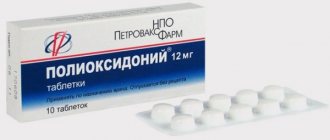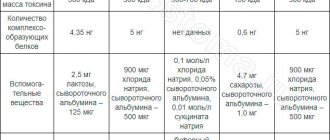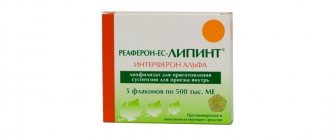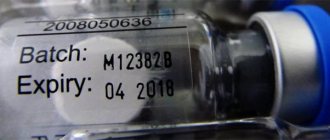Artificial abortions and chronic infectious and inflammatory processes often further deprive women of the happiness of motherhood. And first of all, the cause of persistent infertility is adhesive processes that developed due to gynecological problems that were not recognized in time or not treated. However, today doctors have access to unique techniques and tools that can effectively restore female fertility. And one of them is the Russian innovative drug Longidaza.
Composition of the drug, physicochemical properties and price
The drug is produced in two dosage forms: suppositories (method of administration rectally or vaginally) and lyophilisate to obtain a solution for subcutaneous or intramuscular administration.
Suppositories | Lyophilisate | |
| Main substance | Longidase with hyaluronidase activity: 3000 IU | Longidase with hyaluronidase activity 1500 IU (ampoules and vials 1500 IU) or 3000 IU ampoules and vials 3000 IU) |
| Excipients | Cacao butter | Mannitol 15 mg (1500 IU vials and ampoules) or 20 mg (3000 IU ampoules and vials) |
| Physicochemical characteristics | The candles are elongated, yellowish in color, and have a faint odor of cocoa butter. Marble coloring of the suppository is acceptable. | A porous hygroscopic mass that has a white or white-yellow color. |
| Package | 5 suppositories in contour cells, enclosed in cardboard packs. | 5 ampoules or bottles in blister packs, enclosed in cardboard packs. |
| Price |
|
|
pharmachologic effect
The drug has a prolonged enzymatic proteolytic effect. Prolongation of action occurs due to the covalent binding of longidase to a high molecular weight, active carrier (poly-1,4-ethylenepiperazine N-oxide derivative), which has pharmacological activity.
The covalent bond ensures the enzyme's resistance to destructive reactions and the action of inhibitors, as well as the immediate local presence of a carrier and a hydrolytic enzyme that binds enzyme inhibitors and activators of collagen synthesis (copper, iron, heparin ions). That is why Longidase is able to depolymerize the connective tissue matrix in fibrous-granulomatous structures, as well as suppress the regulatory reaction necessary for the synthesis of structural units of connective tissue.
Glycosaminoglycans such as chondroitin, hyaluronic acid, chondroitin-4 and -6-sulfate are specific substrates of testicular hyaluronidase. They form the basis of the connective tissue matrix. As a result of depolymerization under the influence of hyaluronidase, substrates lose their properties, such as the ability to bind water, viscosity, etc. The conversion of collagen protein into fiber also becomes more difficult, the permeability of tissue barriers increases, the movement of fluid between cells improves, and ultimately the elasticity of connective tissue improves.
Longidase helps reduce the manifestations of the acute phase of inflammation, affects the synthesis of mediators of the inflammatory response, increases infection resistance and increases the tension of humoral immunity.
Pharmacokinetics
When administered parenterally, it quickly enters the systemic circulation, reaching maximum concentration within 20-25 minutes. It is quickly distributed throughout tissues, penetrates into all organs and structures, including the brain, but does not accumulate.
When administered rectally and vaginally, it also quickly enters the bloodstream, reaching a maximum concentration after 1 hour. The bioavailability of suppositories is 70%. Excreted by the kidneys (half-life is 42-84 hours). Metabolized to low molecular weight oligomers.
Known analogues (briefly)
Cheaper analogues of Longidase can be purchased in pharmacies. They have different compositions, but approximately the same operating principle. The drug has no structural substitutes for its main component. The most famous generics:
- Ronidaza. Available in the form of lyophilisate and powder for external use. The enzymatic medicine is obtained from the testes of bulls. Responsible for the breakdown of hyaluronic acid, increasing the permeability of blood vessels. Approximate cost: from 190 rubles.
- Cystamine. Available in tablet form. The active ingredient is a substance of the same name, the concentration of which may vary. It has a radioprotective effect and is responsible for tissue repair. Price - from 300 rub.
- Neovasculgen. The lyophilisate contains plasmid deoxyribonucleic acid. The basis of a gene therapy drug is the human gene. Stimulates normal blood circulation, tissue repair and strengthens the walls of blood vessels. Cost - from 650 rubles.
- Kokkulin. The herbal preparation has antioxidant and immunostimulating effects. Can be taken with kinetosis. The homeopathic remedy is sold in tablet form.
The above medications do not have an effect completely identical to Longidase. They are prescribed only after a complete examination and identification of possible contraindications in the patient to the original medication. The cost of analogues may vary depending on the manufacturer.
Indications for use
Used in complex therapy for children over 12 years of age and adults for pathologies associated with connective tissue hyperplasia. Also prescribed to improve the bioavailability of diagnostic and therapeutic drugs.
Lyophilisate | Suppositories |
Pulmonology, gynecology and urology in the development of an inflammatory reaction of the interstitial type:
Orthopedics, surgery, cosmetology:
Dermatovenerology:
| Urology:
Gynecology:
Dermatovenerology:
Surgery:
|
Lyophilisate
The method of administration and dosage are carried out on an individual basis, based on the severity, clinical picture of the pathology and the age of the person.
According to the instructions for using Longidase in injections, it is indicated that preliminary preparation of the solution is required. The contents of the bottle or ampoule are dissolved in one and a half to two ml of 0.25% or 0.5% procaine solution or in 0.9% NaCl solution, water for injection if procaine is intolerant. The solution cannot be stored, so the preparation field is entered immediately.
Administered subcutaneously near the affected tissue or intramuscularly at a dosage of 3000 IU. A total of 5-15 injections are prescribed with a time interval between each of 3-10 days. Repeated course - after 2-3 months.
For pathologies with a severe chronic process of a productive nature in the connective tissue after treatment, maintenance therapy of 3000 IU is prescribed after 10-14 days.
To improve the bioavailability of other drugs: 1500 IU once every 3 days, the total number of injections should not exceed 10.
Recommended treatment regimens
- Pathologies of the respiratory system: 3000 IU once every 3-5 days - a total of 10 intramuscular injections. Maintenance treatment: 3000 IU once every 10-14 days (up to 12 months).
- Pathologies of the pelvic organs: 3000 IU once every 3-5 days with a course of 5-15 intramuscular injections.
- Scleroderma: 3000-4500 IU once every 3 days with a course of 5-15 intramuscular injections.
- Scars: 3000 IU inside the scar in a dose of once or twice a week for 5-10 injections or 3000 IU once every 3-5 days - a total of 10 intramuscular injections.
- Non-scarring wounds: 1500-3000 IU once every 5 days with a course of 5-7 intramuscular injections.
- Arthritis, contractures, hematomas: 3000 IU once or twice a week, 7-15 intramuscular injections.
- Adhesive disease: 3000 IU once every 3-5 days, 7-15 intramuscular injections.
Contraindications
Longidaza (injections), the instructions for use of which define the drug as well tolerated, have a number of limitations in use.
Among the absolute contraindications:
- hypersensitivity to the main or auxiliary components of the composition;
- bleeding in the lungs or sputum mixed with blood;
- recent hemorrhage in the vitreous region;
- impairment of kidney function (failure) – in acute cases;
- the presence of foci of malignant degeneration;
- pregnancy and breastfeeding;
- acute infections - in such situations Longidaza should be supplemented with antimicrobial drugs.
Longidaza suppositories: instructions for use
Prescribed for rectal or intravaginal administration once a day at night in a course of 10-20 suppositories. For rectal administration, it is recommended to administer the suppository after bowel movement. For intravaginal administration, it is administered in a lying position.
Recommended treatment regimens
- Urology: 1 suppository after 1 day, 10 injections, then after 2-3 days – another 10 injections.
- Gynecology: 1 suppository every two days - 10 injections.
- Dermatovenereology: 1 suppository every one to two days. 10-15 candles per course.
- Surgery: 1 suppository every two to three days. There are 10 candles per course.
- Pulmonology and phthisiology: 1 suppository every two to four days. There are 10-20 suppositories per course. Maintenance treatment - 1 suppository once a week for 3-4 months.
Side effects
Clinical trials and the practice of using injections allow us to draw conclusions about possible negative phenomena and the frequency of their development.
The manual describes the following reactions:
- on the skin - redness, swelling and itching at the injection site (uncommon). Symptoms do not require treatment and disappear within 2–3 days;
- on the part of the immune system – allergic manifestations (extremely rare, 1 case per 10,000 patients);
- general indicators – fever (extremely rare).
Pain often occurs at the injection site.
Drug interactions
Longidase activity decreases with simultaneous treatment with estrogens, salicylates, cortisone, ACTH, and antihistamines in high doses. The increased bioavailability of the second drug should be taken into account when used simultaneously with Longidase.
special instructions
Longidase should not be administered into an area of acute or infectious damage. When treating acute foci of infection, antimicrobial agents are simultaneously prescribed.
If any allergic reaction develops, the drug is discontinued.
Overdose
No such cases have been recorded.
special instructions
The use of the medication can be stopped immediately; withdrawal syndrome does not develop. If during the process the patient forgot to give an injection, the solution can be administered on the same day at any time of the day.
Elderly patients
Elderly patients may need to adjust the dosage regimen downward. It is better to start treatment with half doses.
In pediatrics
Longidaza is not used in pediatrics. Children's age is considered an absolute contraindication.
Use during pregnancy and lactation
During breastfeeding and pregnancy, the drug is prescribed carefully according to health indications. Lactation and gestation are considered relative contraindications.
For impaired renal function
Longidaza is not prescribed to patients with impaired renal function.
Drug interactions
The drug is compatible with most medications. When taken simultaneously, Longidase and anesthetics, antimicrobial, antiviral drugs and diuretics increases the bioavailability of the latter. Nonsteroidal anti-inflammatory drugs, glucocorticosteroids, antihistamines and anthelmintic medications, salicylates, estrogens reduce the effectiveness of the macromolecular complex.
Longidaza has negative compatibility with benzodiazepines, Furosemide and Phenytoin. The medication is prescribed simultaneously with antibiotics (regardless of the group), bronchodilators, bronchodilators and mucolytics.
Interaction with alcohol
5-7 days before the start of treatment with Longidase, the patient is instructed to stop drinking alcohol. Any liquid containing ethanol can provoke the development of malaise in the digestive, respiratory and central nervous system.
Effect on speed and reaction
If the individual treatment regimen is followed, the drug does not in any way affect the speed of psychomotor reactions, therefore driving a car and other vehicles is permitted.








